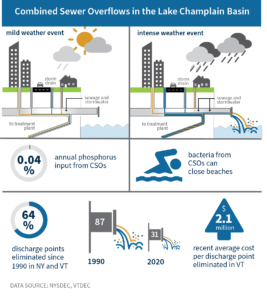Concerns for pathogens can impact recreation on Lake Champlain.
Harmful disease-causing organisms or viruses known as pathogens can be transported from the digestive tracts of animals to any lake or river, including those in the Lake Champlain Basin. These pathogens can be transported in water that comes in contact with pet, wildlife, or livestock waste as it moves through the landscape or in untreated sewage water. Because it is impractical to test lake or drinking water for every waterborne pathogen, drinking water providers and public beach managers instead test for cell counts of coliform bacteria—a group of mostly harmless bacteria that are present in the digestive tract of all animals, including humans. Elevated levels of coliform bacteria may indicate fecal contamination and the possible presence of waterborne pathogens. Elevated coliform bacteria levels in localized areas of Lake Champlain typically only occur following rainstorms that wash bacteria, sediment, and pollutants into the Lake.
Combined sewer overflow events are potential sources of pathogens and are a challenge to eliminate.
To minimize the threat of waterborne pathogens and other pollutants, it is usually best for cities and towns to maintain separate pipe networks to transport stormwater and sanitary sewage independently. However, several municipalities in the Lake Champlain Basin have “combined” systems, where stormwater and sanitary sewage flows are combined in places into one piping network and conveyed to a wastewater treatment facility. When heavy rainfall creates more stormwater runoff than can be accommodated by a combined system, a combined sewer overflow (CSO) allows some of this water to be discharged to a nearby waterway through overflow pipes (Figure 3). During a CSO, untreated or partially treated sewage may then enter a stream or river and eventually the Lake. Although CSOs can be a primary cause of temporary localized elevated coliform bacteria levels, their contribution to Lake Champlain nutrient pollution is insignificant compared to other sources.
Efforts are underway to better understand and address the sources of coliform bacteria in the Lake Champlain Basin’s waterways. The City of Plattsburgh, for example, used DNA tracking technology to determine the source of coliform bacteria that led to public beach closures along the city’s Lake Champlain shoreline. The study found that gulls and cows were the most common sources of coliform bacteria during dry weather conditions and after rainstorms that did not result in CSOs. After storms that resulted in CSOs, the most common sources were gulls, humans, and dogs.
Substantial efforts have been made to reduce the number of CSO events in the Lake Champlain Basin. Since 1990, the number of CSO discharge points in the New York and Vermont portions of the Basin has decreased from 87 to 31. Municipalities throughout the Basin are working to reduce pressure on their stormwater systems by separating their systems, eliminating discharge points, upgrading their treatment facilities, and implementing green stormwater infrastructure projects to reduce stormwater inputs.



